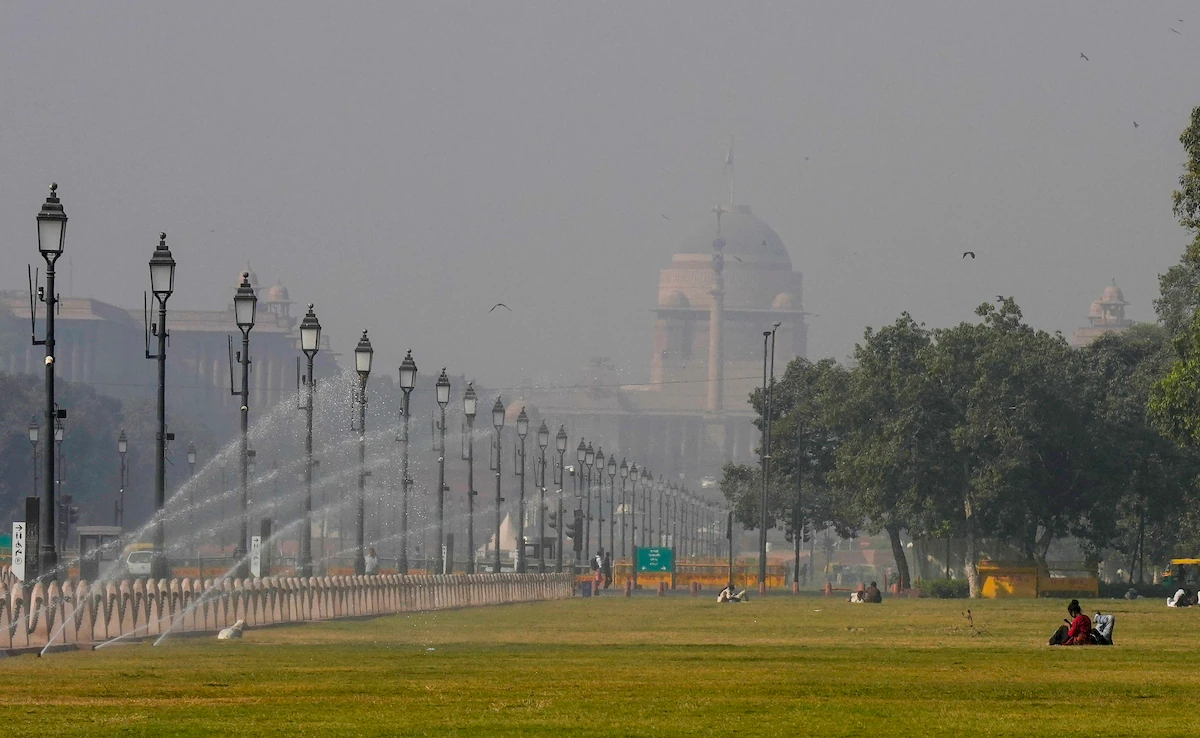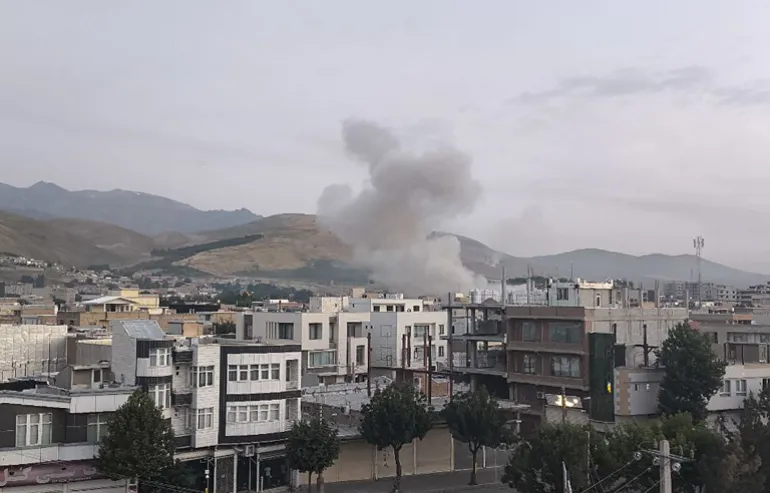- Courses
- GS Full Course 1 Year
- GS Full Course 2 Year
- GS Full Course 3 Year
- GS Full Course Till Selection
- Answer Alpha: Mains 2025 Mentorship
- MEP (Mains Enrichment Programme) Data, Facts
- Essay Target – 150+ Marks
- Online Program
- GS Recorded Course
- NCERT- First Ladder
- Polity
- Geography
- Economy
- Ancient, Medieval and Art & Culture AMAC
- Modern India, Post Independence & World History
- Environment
- Governance
- Science & Technology
- International Relations and Internal Security
- Disaster Management
- Ethics
- Current Affairs
- Indian Society and Social Issue
- CSAT
- 5 LAYERED ARJUNA Mentorship
- Public Administration Optional
- ABOUT US
- OUR TOPPERS
- TEST SERIES
- FREE STUDY MATERIAL
- VIDEOS
- CONTACT US
PLACES IN NEWS 30 October 2024
PLACES IN NEWS 30 October 2024
30-10-2024
Land Ports Authority of India (LPAI)
In October 2024, the union home minister inaugurated a new Passenger Terminal Building and a Maitri Dwar in Petrapole, West Bengal.
- Cost: The project was built at a cost of ₹487 crore by LPAI.
About LPAI
- Establishment: Constituted under the Land Ports Authority Act, 2010.
- Purpose: Development and management of facilities for cross-border movement of passengers and goods at designated international border points in India.
- Responsibilities:
- Create, upgrade, maintain, and manage border infrastructure in India.
- Manage Integrated Check Posts (ICPs) across India's borders.
- Leadership: Chairperson and Members appointed by the Central Government.
- Tenure:
- Five years from the date of assuming office or until the age of sixty, whichever comes first.
- Functions: Develop, sanitize, and manage facilities for cross-border movement of passengers and goods.
- Nodal Ministry: Ministry of Home Affairs
Key Points about Petrapole
- Significance: Largest land port in South Asia.
- Gateway: Vital for trade and commerce between India and Bangladesh.
- Passenger Movement: Eighth largest international immigration port in India, facilitating over 23.5 lakh passengers annually between the two countries.
Konark Sun Temple
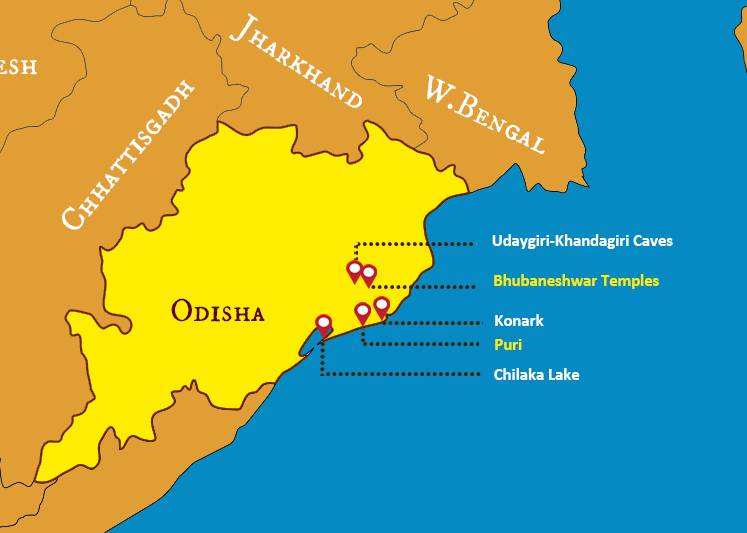
Prime Minister's Reference: Recent mention in the Prime Minister’s ‘Mann Ki Baat’ regarding Odissi dance and the Konark temple.
About Konark Sun Temple
- Location: Puri district, Odisha, along the coastline.
- Alternative Name: Surya Devalaya (dedicated to the Hindu god Surya).
- Historical Background: Constructed in 1250 by Narasimha I of the Eastern Ganga dynasty (reigned 1238-1264).
- UNESCO World Heritage Site: Designated in 1984.
Architectural Features
- Style: Classic example of Odisha/Kalinga architecture.
- Design: Resembles a 100-foot-high solar chariot with 24 wheels pulled by six stone-carved horses.
- Orientation: Faces east, allowing sunrise rays to illuminate the main entrance.
- Sundials: The wheels serve as sundials for accurate time calculation to a minute.
- Decorative Elements:
- Base adorned with images of animals, foliage, warriors on horses, and intricate structures.
- Elaborate stone carvings depicting scenes from Hindu mythology.
Material and Nickname
- Construction Material: Built from Khondalite rocks.
- Nickname: Known as 'BLACK PAGODA' due to its dark color.
- Worship Site: Continues to be a site for Hindu worship, especially during the annual Chandrabhaga Festival in February.
Rajgad Fort
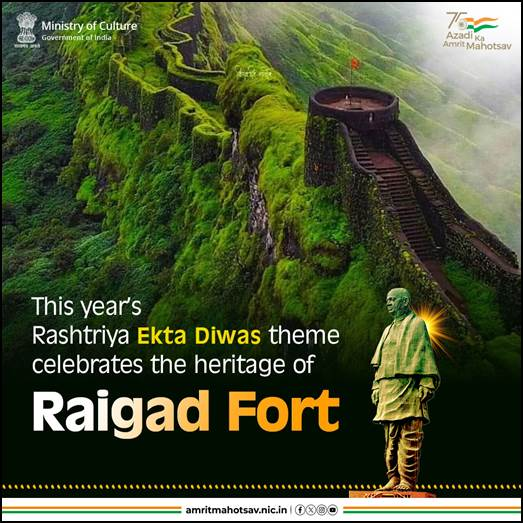
- A replica of Raigad Fort was created as a backdrop for the Rashtriya Ekta Diwas parade in Kevadiya.
- Purpose: To showcase the valor, heroic deeds, and innovative warfare techniques of Chhatrapati Shivaji Maharaja.
About Rajgad Fort
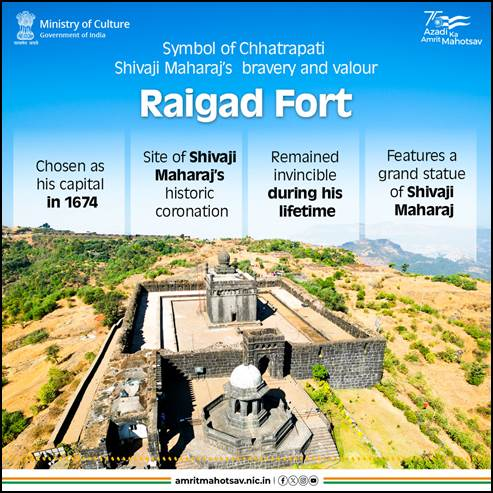
- Location: Hill fort in Raigad district, Maharashtra.
- Geography: Surrounded by valleys shaped by the Kal and Gandhari rivers; stands as an isolated massif without connections to neighboring hills.
- Historical Comparison: British historian Grant Duff referred to Raigad as the "Gibraltar of the east."
History
- Capture: In 1653 CE, the fort (then Rairi) was taken by Maratha forces from the Mores.
- Reconstruction: Shivaji Maharaj tasked Hiroji Indulkar with its reconstruction.
- Coronation: On June 6, 1674 CE, Shivaji Maharaj was crowned "Chhatrapati" at Raigad, which served as the second capital of the Maratha Kingdom.
Features
- Gates: Two main gates, Nana Darwaza and Maha Darwaza, both flanked by bastions.
- Structures:
- Naqqar Khana (Drum House)
- Sirkai Devi Temple
- Jagadishwar Temple (dedicated to Lord Shiva)
- Hall of Public Audience (Rajsadar)
- Royal Complex
- Queens' Palace (Bazarpeth)
- Manore (pleasure pavilions)
- Wadeshwar Temple
- Khublada Burj
- Massid Morcha
- Nanne Darwaza
- Royal Complex: Known as Balle Qilla (citadel), includes Ranivasa, Rajsadar, Naqqarkhana, Mena Darwaja, and Palkhi Darwaja; well-fortified with three main entrances.
- Rajsadar (Hall of Public Audience): The site where Shivaji Maharaj held court to dispense justice and receive dignitaries.
- Holicha Mal: An open ground outside Naqqarkhana, likely used for the annual Holi festival.
UNESCO Status: Heritage Site: Raigad is part of the 12 forts nominated for UNESCO World Heritage under "Maratha Military Landscapes of India."
Mount Fuji

Recent Event in October 2024: Mount Fuji remained snow-less recently, marking the latest date without snow in 130 years of recorded history.
About Mount Fuji
- Height: The highest mountain in Japan at 3,776 meters.
- Location:
- Close to the Pacific coast.
- Situated in Yamanashi and Shizuoka prefectures, approximately 100 km southwest of the Tokyo-Yokohama metropolitan area.
- Geological Classification:
- A stratovolcano, dormant since its last eruption in 1707 but still classified as active.
- Prominent summit crater formed from numerous basaltic lava flows.
Characteristics
- Shape:
- Smooth slope with a wide base.
- Creates a beautiful skyline tapering to a magnificent peak.
- Volcanic Activity:
- Main cause linked to the Pacific Plate subducting beneath the Philippine Plate.
Surroundings
- Fuji Five Lakes (Fuji Goko):
- Located on the northern slopes:
- Lake Yamanaka
- Lake Kawaguchi
- Lake Sai
- Lake Shōji
- Lake Motosu
- Formed by lava flow damming effects.
- Located on the northern slopes:
Cultural and Natural Significance
- Snow Cover: Summit is usually covered in snow most of the year.
- National Park: Major feature of Fuji-Hakone-Izu National Park.
- UNESCO World Heritage Site: Designated in 2013.
Must Check: Best IAS Coaching In Delhi
UPSC Prelims Result 2024 Out: Expected Cut Off & Other Details, UPSC Prelims 2024 Answer with Explanation, Daily Prelims Quiz, Daily Current Affairs, MONTHLY CURRENT AFFAIRS TOTAL (CAT) MAGAZINE, Best IAS Coaching Institute in Karol Bagh, Best IAS Coaching Institute in Delhi, Daily Mains Question Answer Practice, ENSURE IAS UPSC Toppers, UPSC Toppers Marksheet, Previous Year Interview Questions, UPSC Syllabus



